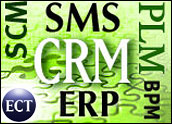
The time has come for not only a new faith in CRM but a new following — by small and midsize companies.
Since Redmond, Washington-based Microsoft introduced a CRM product to its Business Solutions line in January 2003, it has captured more than 2,500 small and midsize organizations representing more than 100,000 unique users.
“Anytime a company as big as Microsoft decides it’s going to enter a market, it is going to attract attention,” Julie Giera, vice president at Forrester Research of Cambridge, Massachusetts, said in reference to the adoption of Microsoft CRM.
The arrival of Microsoft’s CRM product has attracted more small and midsize enterprise (SME) companies to consider CRM packages — especially Microsoft’s offering, with its support from research and development resources and technical support, Giera said. “Microsoft is far and away the leader with this solution,” she added, and the bearer of news that CRM is appropriate for, and will be applied to, SMEs.
Microsoft has garnered a lot of business with its off-the-shelf CRM solution, but other developers also have basked in the bright light Microsoft has brought to CRM.
Bright Light
Small and midsized businesses may never have outright shunned CRM, even after hearing the sob stories of large enterprises that purchased CRM software that subsequently performed poorly. However, only a segment of the SME marketplace had considered adopting CRM.
“I think that when Microsoft turns to a market, it always shines a light on that market,” said Liz Roche, vice president and practice leader at Meta Group of Stamford, Connecticut. “The midmarket traditionally has been underserved. There’s a real dearth of vendors at that level.”
Microsoft’s entry at the midmarket level also has inspired competitive products from Siebel and SAP.
Meanwhile, midmarket enterprises must learn from the large global companies that preceded them into CRM. They must understand that CRM is not merely a technology but also a business solution.
However, that’s not a reason to wait any longer to begin using CRM. “Today there’s enough on the shelf that any organization should be able to buy some sort of CRM canned, and plan to build around it,” Roche concluded.
Giera said Microsoft’s CRM product will excel because of its accessibility, especially given the company’s vast partner network in which add-on products and tailored solutions emerge frequently, buttressed with plenty of support from the reseller network.
Other Products
“I think Microsoft CRM will allow businesses accessibility they’ve never had,” Giera said. It offers improved integration with widely used tools, such as Outlook. Naturally, many of the applications that SMEs would like to be able to integrate with a CRM solution are Microsoft products. For that reason, many companies already using Microsoft software might choose to integrate Microsoft CRM into their businesses.
But Giera’s words came with a warning. “The big mistake made by larger companies in installing CRM solutions was in thinking that the software was going to do everything,” she said.
That’s why Ben Holtz, president of Green Beacon Solutions of Watertown, Massachusetts, refuses to do product demonstrations in the first meeting with a prospective client. He spends that first day discussing the client’s business only so as to determine which off-the-shelf product would fit best.
“CRM is not rocket science. It’s almost a bit like accounting software,” he said. “There’s no reason to start fresh.”
However, it is important to find a malleable platform, one that fits with an SME’s business model.
Holtz said, “You can’t do a good job implementing CRM if you don’t understand your business process. It’s the bottoms-up approach to software development.” An SME must look at its business inputs and match the CRM software to its operations, because the software merely aids the business process; it doesn’t replace the business process and run the company automatically.
Awareness Raised
“Microsoft came out with Microsoft CRM with a fanfare, and it’s done something to the market,” Holtz concluded. “It’s brought CRM awareness to a group of people who previously didn’t care or see the need for CRM.”
Yacov Wrocherinsky, president and CEO of Infinity Info Systems of New York, concurred. “There are 80 million people who don’t have anything,” he said. “The number one competitor to CRM today is nothing. It’s 3-by-5 cards or a Rolodex.
“Every business needs CRM,” he continued. “Microsoft is in the process of creating a big awareness for the industry. We’re living in historic times. It’s like the birth of the word processor.”
History evidently hasn’t been lost on the U.S. market. In the 18 months since its launch, Microsoft CRM has extended its international reach and is currently available in nine languages and more than 53 countries. In the fourth quarter of this calendar year, Microsoft CRM will be available in an additional five languages.
This story was originally published on August 31, 2004, and is broughtto you today as part of our Best of ECT News series.




















































